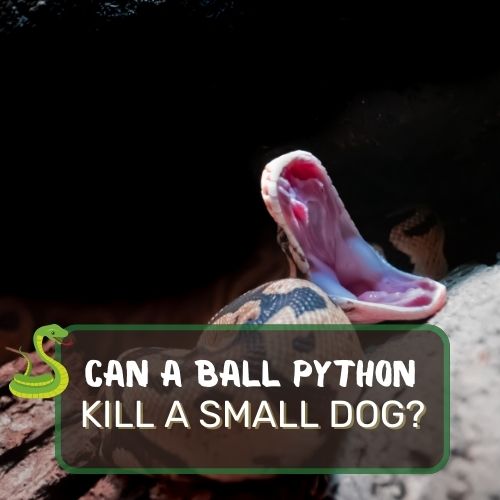
It’s a question that has crossed the minds of many pet owners, especially those who share their homes with both reptiles and canines.
This article delves deep into the dynamics between ball pythons and small dogs, shedding light on the potential risks and realities of their interactions.
We’ve examined factors such as the natural behavior of ball pythons, the size comparison between the snake and small dogs, and the signs to look for if a bite occurs.
By the end of this read, you’ll have a comprehensive understanding of the relationship between these two species and the steps to ensure a harmonious coexistence in your household.
Dive in and discover the fascinating world of pythons and pups!
Table of Contents
- 1 Can a Ball Python Kill a Small Dog?
- 2 Why Will Ball Pythons Attack Dogs? Triggering Factors
- 3 Size Comparison of an Adult Ball Python to Small Dogs
- 4 Creating a Safe Environment Between Your Ball Python And Dog
- 5 Signs That a Dog Has Been Bitten By a Ball Python
- 6 First Aid for Dog Bites by Ball Pythons
- 7 Conclusion
- 8 More Questions
Can a Ball Python Kill a Small Dog?
While ball pythons are constrictors and have the ability to wrap around and constrict their prey, the likelihood of one killing a small dog is extremely low. Ball pythons typically prey on smaller animals like rodents. An adult chihuahua or similar small dog is much larger than what a ball python would consider as prey. Moreover, dogs are agile and would likely resist any attempt by the snake.
However, it’s essential to always supervise interactions between any snake and other pets. In theory, a ball python might pose a risk to a very young or tiny puppy, but in reality, such incidents are rare.

Why Will Ball Pythons Attack Dogs? Triggering Factors
Ball pythons, with their serene demeanor and captivating patterns, are among the most sought-after reptiles in the pet world. But, like any creature, they have their quirks and triggers.
So, let’s dive deep into the reasons why a ball python might decide to take on a small dog, even if it’s just a tiny chihuahua.
Reasons why ball pythons might feel threatened and attack
First and foremost, it’s essential to understand that ball pythons are not naturally aggressive towards larger animals, including dogs. Their primary diet consists of rodents, and they use their constricting ability to subdue their prey.
However, if a ball python feels threatened or cornered, it might strike out in defense. Imagine you’re chilling at home, and suddenly a creature many times your size decides to poke you.
You’d probably react defensively too, right? The same goes for our slithery friends.
The role of the owner in such situations
Owners play a pivotal role in these interactions. If you’re introducing a new pet to your home, be it a ball python or a small dog, it’s crucial to ensure that both animals are comfortable and secure.
An anxious or stressed ball python is more likely to act defensively. So, if you’re thinking of snapping that Instagram-worthy photo of your python and pup together, ensure both are calm and at ease.
Remember, it’s not just about the photo op; it’s about the well-being of both your pets.
The python’s behavior during its shedding phase
Ah, the shedding phase! This is a time when ball pythons can be a tad more irritable. Their vision is compromised due to the old skin covering their eyes, making them more jumpy and defensive.
If your dog, out of sheer curiosity, decides to sniff or poke the python during this phase, the snake might perceive it as a threat and react. It’s akin to someone sneaking up on you when you’re in a deep sleep. Not the best feeling, right?
The idea of a ball python taking on a small dog might sound like a scene straight out of a wild nature documentary but in reality, it’s a rare occurrence.
With proper care, understanding, and a dash of common sense, both your slithery and furry friends can coexist peacefully.
Just remember to always be observant, especially during those unique phases like shedding, and ensure both pets have their own safe spaces.

Size Comparison of an Adult Ball Python to Small Dogs
When it comes to the animal kingdom, size matters. It often dictates who’s the predator and who’s the prey. But when we’re talking about household pets, the dynamics can be a tad different.
Let’s delve into the size comparison between an adult ball python and our beloved small dogs.
Average Size of an Adult Ball Python
Ball pythons are not the giants of the snake world. An adult ball python typically measures between 4 to 6 feet in length. Their girth, while substantial, isn’t overly intimidating. Think of them as the size of a thick garden hose.
While they have the strength to constrict and subdue their prey, their size is more suited for smaller animals like rodents.
The Petite World of Small Dogs
Now, let’s talk about our furry friends. Small dog breeds, such as Chihuahuas, Pomeranians, and Toy Poodles, usually stand about 6 to 10 inches tall at the shoulder. Their weight? Often no more than 4-6 pounds.
While they might be tiny, they’re packed with energy, agility, and sometimes, a good dose of feistiness.
Putting It Into Perspective
When you place a ball python next to a small dog, the size difference is evident. While the snake might be longer, the dog has the advantage in terms of agility and mobility.
A Chihuahua, with its swift movements and sharp barks, can easily startle a ball python. On the flip side, a ball python’s length might seem intimidating, but it lacks the quick reflexes of our canine companions.
In essence, while ball pythons have the length, small dogs have the agility. It’s a fascinating comparison, showcasing that in the world of pets, size is just one piece of the puzzle.
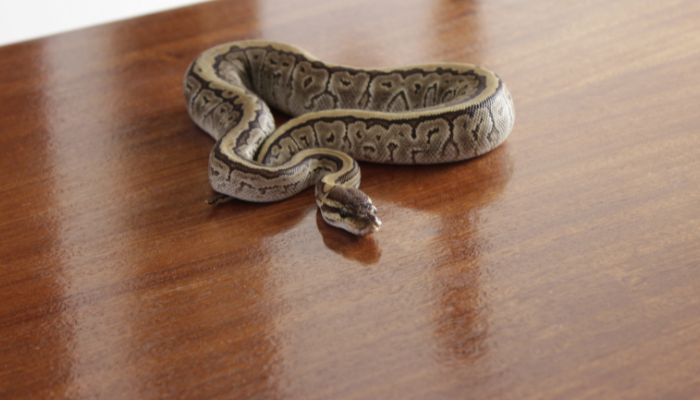
Creating a Safe Environment Between Your Ball Python And Dog
When you have a household with diverse pets, harmony is the key. It’s like having a multi-genre playlist; each song is beautiful on its own, but they might not always blend well together. The same goes for your ball python and small dog.
Let’s explore how to create a harmonious environment for both.
The Importance of Designating Separate Rooms
Having separate spaces for your ball python and dog is crucial. Think of it as giving each of them their own private suite. This not only ensures safety but also reduces stress for both animals. Dogs are naturally curious creatures.
If they sense something moving in a snake enclosure, their instinct might drive them to investigate, leading to potential mishaps. On the other hand, a ball python needs a calm environment, free from sudden disturbances.
By designating separate rooms, you’re setting boundaries and ensuring peace.
Ensuring the Security of the Python’s Enclosure
A secure enclosure is not just a luxury; it’s a necessity. Ball pythons are escape artists. Given a chance, they might try to explore outside their habitat. Ensure the enclosure has a sturdy lock and is escape-proof.
This not only keeps the python safe but also prevents any unexpected encounters with your dog. Remember, an ounce of prevention is worth a pound of cure.
Recommendations Against Letting the Two Pets Interact
While it might be tempting to introduce your ball python to your dog, it’s a risk not worth taking. Both animals communicate differently, and misunderstandings can lead to stress or even injury.
Your dog’s playful poke might be perceived as a threat by the python, leading to defensive behavior. Conversely, a curious python might startle a dog, leading to a panicked reaction.
It’s best to admire their unique qualities separately rather than forcing a potentially stressful interaction.
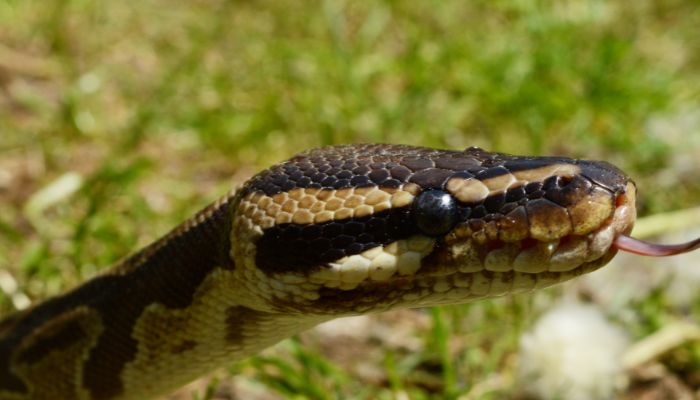
Signs That a Dog Has Been Bitten By a Ball Python
If you suspect your dog has had an unsupervised encounter with your python, it’s crucial to know the signs of a snake bite. Let’s delve into the indicators that your canine companion might have been bitten.
Identifying Bite Marks
Ball python bites are distinct. Unlike venomous snakes that leave two puncture wounds, a ball python’s bite will often appear as a series of small punctures in a row, resembling a zipper pattern.
These are the marks left by the snake’s multiple rows of backward-facing teeth. The area might be red and swollen, especially if the dog reacts by pulling away, causing minor tears.
Observing Behavioral Changes in the Dog
Dogs are expressive creatures. If they’re in pain or discomfort, they’ll show it. Post-bite, your dog might appear more agitated or anxious. They might whimper, show restlessness, or become more reclusive.
It’s essential to monitor their behavior closely, especially in the hours following a suspected bite.
The Significance of Excessive Licking or Scratching
Dogs have a natural instinct to lick or scratch at areas that bother them. If your dog is continuously focusing on one spot, licking, biting, or scratching it, it might be the site of a snake bite.
This behavior is their way of soothing the discomfort or cleaning the wound.
While a bite from a ball python is rarely severe, it’s essential to be vigilant and recognize the signs. If you suspect a bite, consult with a veterinarian to ensure your dog’s health and well-being. Remember, it’s always better to be safe than sorry.
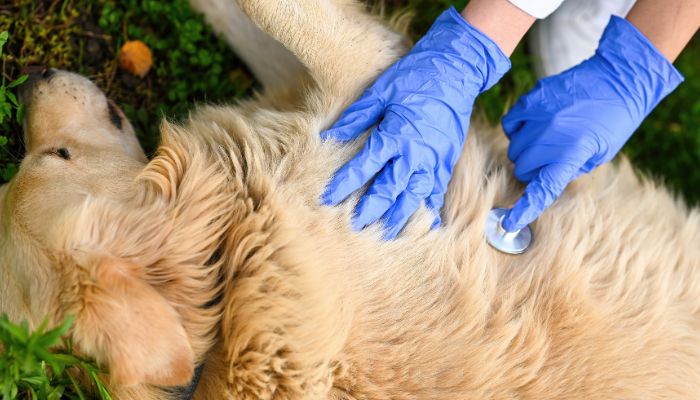
First Aid for Dog Bites by Ball Pythons
Discovering that your dog has been bitten by a ball python can be a nerve-wracking experience. While these bites are typically not venomous, they can still cause discomfort and potential infection if not treated promptly.
Let’s explore the immediate steps you should take if your furry friend has been bitten.
The Importance of Securing the Dog
First and foremost, ensure your dog’s safety. Move the dog away from the python to prevent any further altercations. It’s essential to remain calm during this process.
Dogs can pick up on our emotions, and if they sense panic, they might become more agitated. Gently hold your dog, offering soothing words and strokes to keep them calm.
If possible, place them in a secure area where they can’t further injure themselves.
Cutting the Hair Around the Wound
Once your dog is calm, it’s time to assess the wound. For a clearer view, you might need to trim the hair around the bite area.
This not only allows for a better assessment but also ensures that when you disinfect the wound, the solution reaches the skin effectively. Use a pair of clean scissors and be gentle, ensuring you don’t cause any additional discomfort.
Disinfecting and Bandaging the Wound
After clearing the area, clean the wound using an antiseptic solution. This step is crucial to prevent any potential infections. Gently dab the solution onto the bite marks, ensuring they’re thoroughly cleaned.
Once disinfected, apply a topical antibiotic ointment to further prevent infection. Finally, cover the wound with a sterile bandage. This not only keeps the area clean but also prevents your dog from licking or scratching at it.
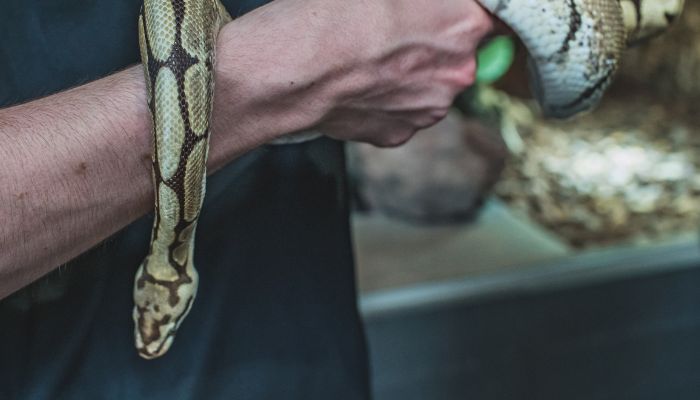
Conclusion
understanding the natural behaviors of both animals and ensuring a safe environment, you can mitigate potential risks. Recognizing signs of distress or injury and knowing the appropriate first aid measures further equip you to handle any unexpected situations.
Remember, knowledge is power. By educating yourself on this topic, you’re taking proactive steps to ensure the well-being of both your slithery and furry companions.
With the right precautions and a dash of understanding, your household can be a harmonious sanctuary for all its inhabitants.
So, take a moment to appreciate the unique qualities of each pet and celebrate the diverse world of animal companionship.
You’re well on your way to becoming an exemplary pet owner, fostering a safe and loving environment for all. Keep up the great work!
More Questions
In the world of pets, especially when it involves species as diverse as dogs and pythons, numerous questions arise. Let’s tackle some of the most commonly asked queries to shed light on the dynamics between these two animals.
Can a ball python hurt a small dog?
While ball pythons are generally docile, they can, in theory, hurt a small dog, especially if they feel threatened. Their primary defense mechanism is to constrict, but they might also bite in self-defense. However, the likelihood of a ball python causing serious harm to a small dog is relatively low.
Will a python eat a small dog?
Ball pythons typically prey on smaller animals like rodents. A small dog, even a tiny one like a chihuahua, is much larger than their usual prey. So, while it’s theoretically possible for a very large python to consider a very small dog as prey, it’s highly unlikely for a ball python.
What to do if a python attacks your dog?
Immediate intervention is crucial. Gently but firmly uncoil the python from your dog, starting from the tail and working your way up. Once separated, ensure both animals are safe and secure in separate areas.
Are snakes afraid of small dogs?
Snakes, including ball pythons, are generally wary of larger animals, including small dogs. The movement and noise of a dog can be intimidating to a snake, making them more likely to retreat than engage.

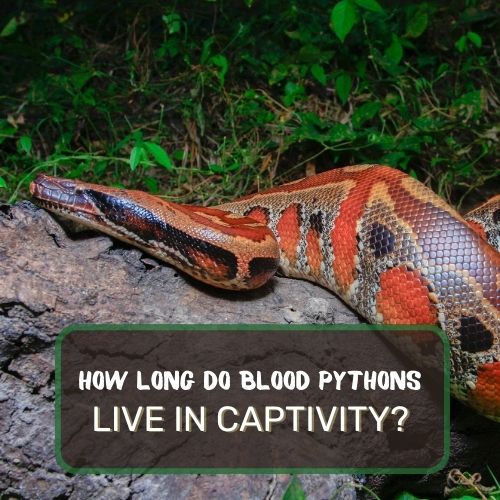


0 Comments